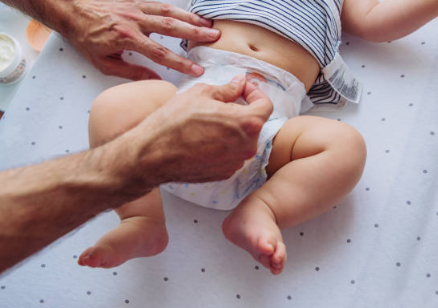In the first few years of life, your baby will poop and pee almost all day. A large number of dirty diapers can be overwhelming for new parents, and it can cost hundreds of dollars per year. Stock up on supplies can save you money in the long run, but if you’re a newbie new to parenthood, there are a few things you might want to know.

First, “Well, how many diapers does a baby need to change a day?” Second, “How many diapers should I buy at a time?” It’s hard to know for sure the exact answer for three reasons:
- On average, newborns use about 8 to 12 diapers per day. But every baby is different, so you must learn how to predict how much your newborn will need to change.
- Diaper size is based on weight and not age. Every baby grows at a different rate, so it’s almost impossible to predict which size they’ll need when they’re 3 months old, 18 months old, etc.
- Diaper needs adjust as the baby grows. Your child needs the most diapers during the neonatal period. By the time they reach potty training age, they may only need four or five daily diapers.
That said, if parents want to estimate how many diapers they need, it’s best to break them down by size. Most manufacturers produce diapers in “newborn” sizes (10 pounds and under) to size 6 (35 pounds and above). Some brands, such as Curiosity and Pampers, also produce “premature” diapers for babies under 6 pounds, while others offer size 7 diapers for toddlers up to 41 pounds and older.
As with most things, you can save money by buying diapers in bulk. A “box” contains more diapers than a “bag” – for example, a size 1 bag typically has 40 diapers, while a size 1 box contains about 164 diapers. Boxed diapers are usually less expensive, but do your research and budget accordingly.
Diaper Size Buying Guide
Here’s a size guide to help you estimate how many diapers you’ll need, but remember to take it with a grain of salt, as every baby is different. Also note that as the size of the diaper increases, the number of diapers in each box usually decreases. For example, you might get 164 diapers in box 1, but only 136 diapers in box 3.
Premature babies (6 pounds and under): Generally, only premature babies need this diaper size. There is no way to predict whether your baby will be born prematurely and how big your baby will be, so plan to buy these diapers as needed.
Newborns (10 pounds and under): Small babies grow quickly, so they come out of their newborn diapers after a few weeks. Plan to use about 8-12 diapers per day, which equates to about one to two boxes (assuming each box contains 140 diapers). Please note that many parents also receive newborn diapers from the hospital.
Size 1 (8 -14 lbs): Most babies need size 1 diapers until 4 months of age, and they get about 8-10 diapers soiled per day. Therefore, based on the calculation of 164 diapers per box, parents can plan to buy about three to four boxes.

Size 2 (12-18 lbs): These sizes are commonly used by babies between the ages of 3 and 8 months, and they produce eight to nine dirty diapers per day. Expect to buy three to five boxes, each containing 142 diapers.
Size 3 (16-28 lbs): Now it’s time for storage to start coming in handy. Many babies need a size 3 diaper – in fact, it is common for babies between 5 months and 24 months to use a size 3 napp. At this age, babies change six to seven diapers a day, so you’ll need about seven to eight boxes, assuming 136 diapers per box.
Size 4 (22-37 lbs): Size 4 diapers are typically suitable for babies between 18 months and 36 months, who stain about 5 to 7 diapers per day. Because many babies don’t need No. 4 diapers until they are almost 2 years old, many parents choose not to stock up early. Expect two to five boxes to be used anywhere.
Size 5 (27-35 lbs): Size 5 diapers are suitable for toddlers 27 pounds and older, and children generally reach this weight around 3 years of age. Plan to purchase and use these diapers as needed.
Size 6 (35 pounds and above): As the largest size produced by many brands, size 6 diapers are typically reserved for people over the age of 4. Plan to purchase and use these diapers as needed.
Size 7 (41 pounds and above): Some brands, such as Pampers, also produce size 7 diapers for older toddlers. Once your child reaches 41 pounds, weigh the situation and purchase these diapers accordingly.

When estimating how many diapers you’ll need, keep the following important things in mind:
- Most parents have a preferred diaper brand and it takes some trial and error to find out. You may need to postpone storage until you’ve tested a few different options. This applies even if you have used the preferred brand with another baby. Every baby is different, and you may find that different brands are better suited for your next baby.
- Some diaper brands are smaller in size than others. If you’re worried about the fit, read product reviews or ask other parents about their experiences.
- Some babies have overlapping weights between different diaper sizes. If you don’t know which size to buy, consider your child’s body structure. Larger babies may need a larger option, while a longer baby may be best suited for a smaller option.
How Much Do Diapers Cost?
Disposable diapers don’t come cheap. While the cost depends on a number of factors, including the brand and package size, parents expect to spend a considerable amount of money over the years.
Here’s the rough picture: The average price of a diaper ranges from $0.20 to $0.30. Assuming your baby uses 2,500-3,000 diapers in the first year, you can expect to use around $500-$900 per year. This does not include the cost of other diaper supplies, such as wipes and changing tables. Buying eco-friendly products can also increase prices by hundreds of dollars.
Of course, there are many ways to save money on diapers. Try using coupons, looking for discounts online, buying in bulk, stocking up whenever you see low-priced diapers, and trying lower-priced options. Some parents also believe that cloth diapers save money, but it can be more laborious to wash diapers (or use diaper services) after each use.
